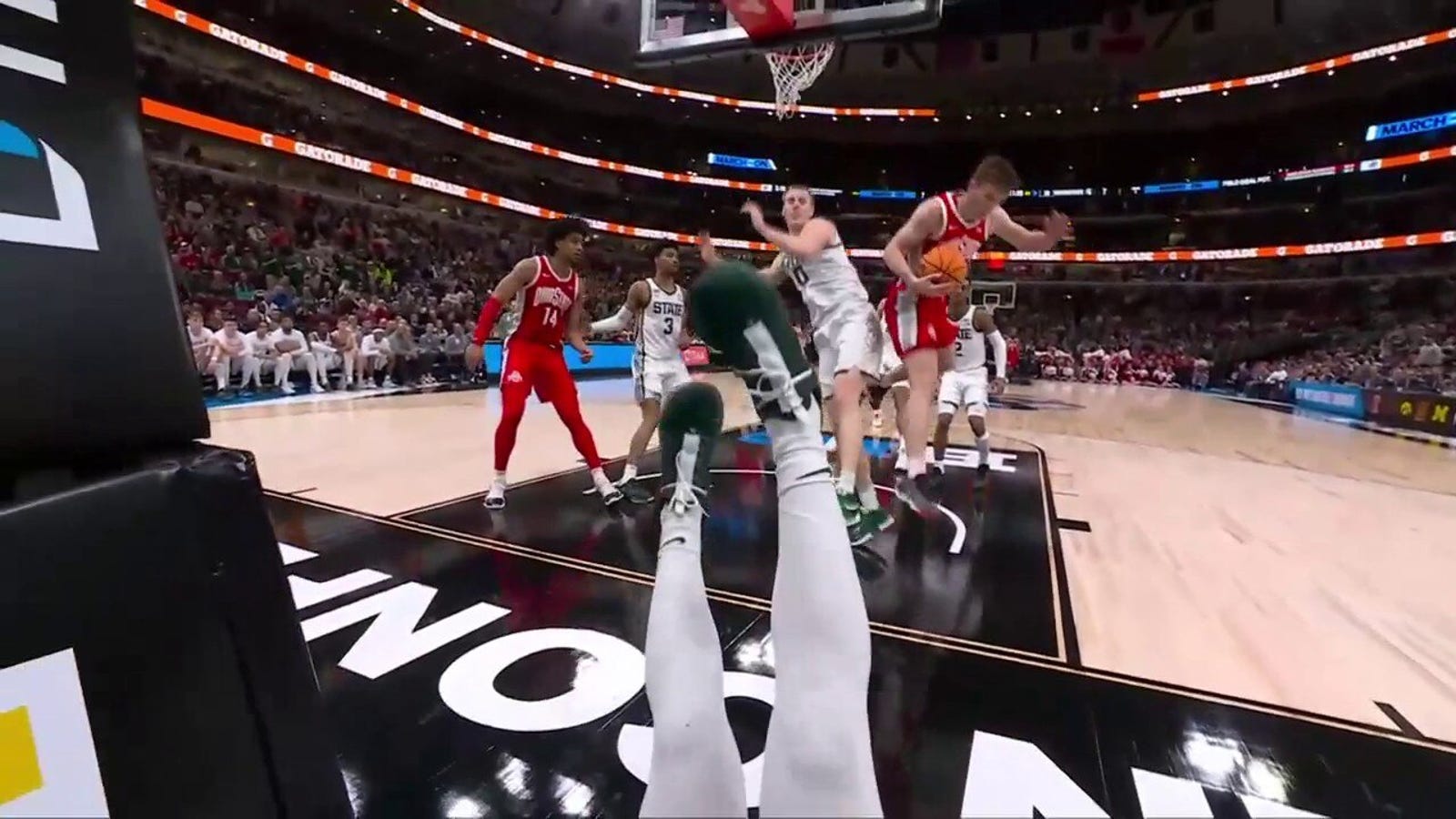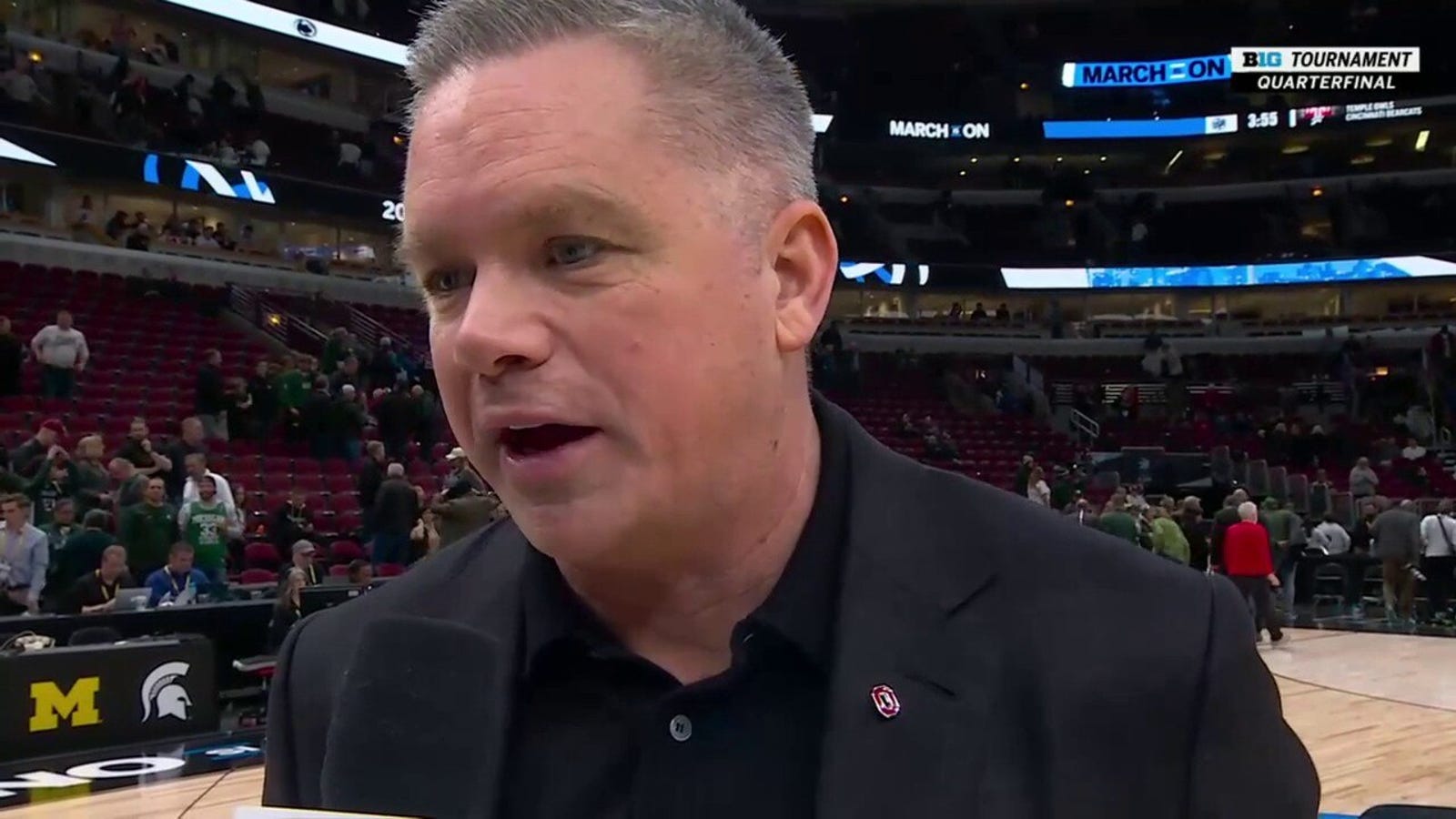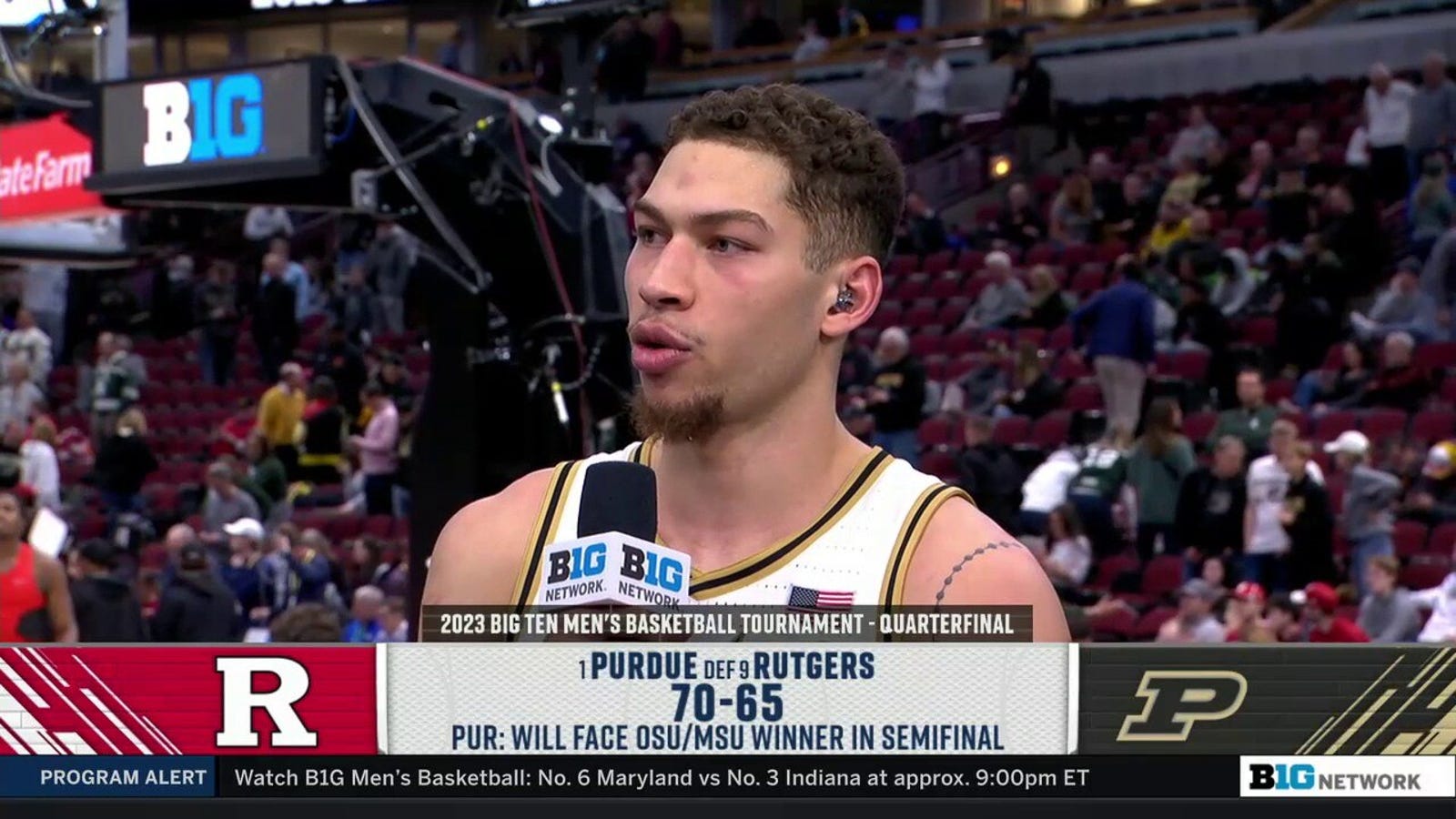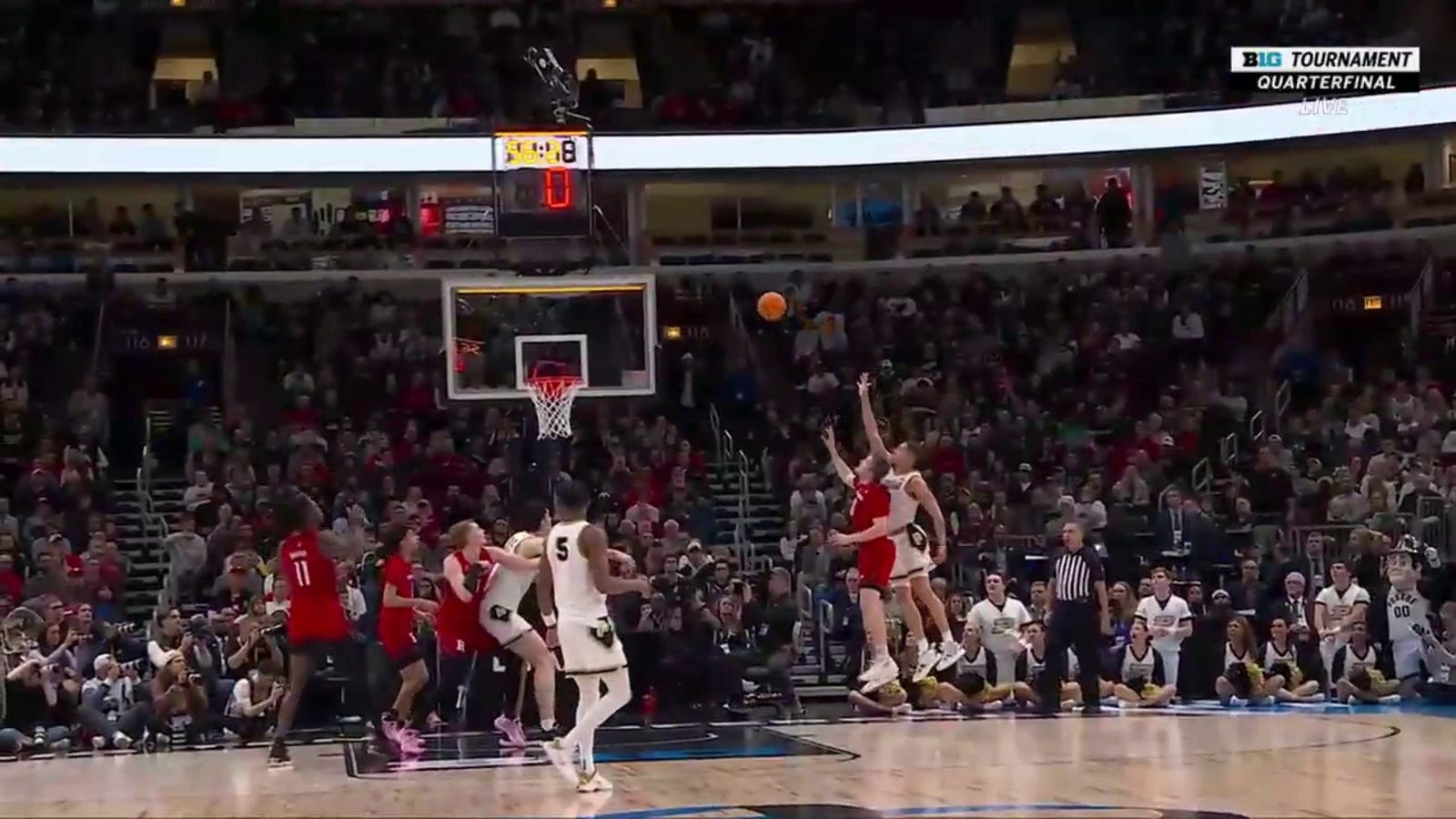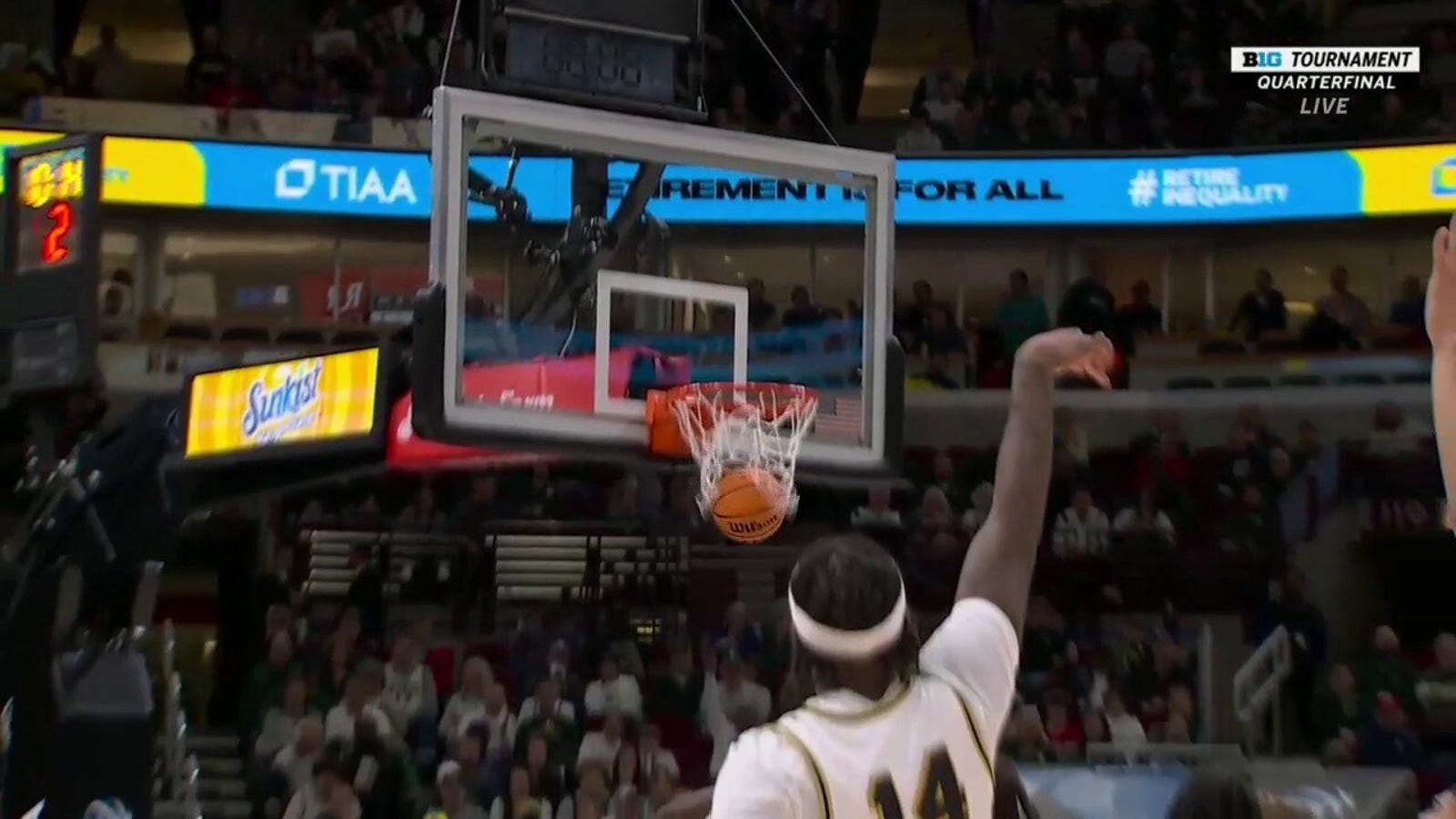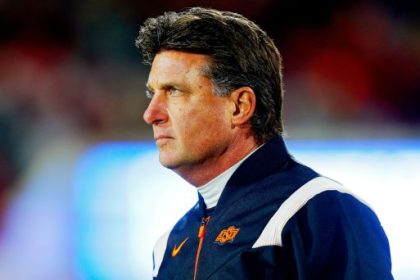Note: Michael Cohen is sharing takeaways on the action throughout the Big Ten Tournament.
Game 2: Ohio State 68, Michigan State 58
CHICAGO — Bruce Thornton and Justice Sueing grinned as their paths crossed just beyond midcourt. They smiled at each other — a true freshman and a sixth-year senior who fueled their team to victory — and locked their hands in a warm embrace. They walked off the United Center court reveling in the magic of a third consecutive upset that kept an unlikely dream of an improbable NCAA Tournament bid afloat.
Together, Thornton (21 points, six assists, four rebounds) and Sueing (14 points, four rebounds) guided Ohio State to a 68-58 win over fourth-seeded Michigan State in Friday’s quarterfinals of the Big Ten Tournament. The Buckeyes, who were without leading scorer Brice Sensabaugh (knee soreness), led for more than 33 minutes of a comprehensive victory that leaves head coach Chris Holtmann and his team two wins from March Madness, despite owning a 16-18 record that encapsulates how dreary most of the season has been.
ADVERTISEMENT
Fueled by a 10-for-19 shooting clip from beyond the arc, Ohio State built a lead that grew to 14 points in the closing moments of what finished as a fairly comfortable win. The Buckeyes will face top-seeded Purdue in the first semifinal on Saturday afternoon.
Four double-figure scorers weren’t enough for the Spartans to overcome a dismal perimeter shooting effort and almost as many turnovers (eight) as assists (nine).
Ohio State’s Bruce Thornton makes the quick bucket
Ohio State’s Sean McNeil makes a great save and throws it to Bruce Thornton, who lays it in.
Learning on the fly
There’s an interesting metric on KenPom, the popular college basketball analytics website, called “minutes continuity.” On a team-by-team basis, it measures what percentage of minutes are being played by the same personnel as the prior year. Generally speaking, teams who return most of their players from the last season will have more continuity than programs that experience widespread turnover.
Ohio State ranks 346th in that category for the 2022-23 season with just 12.5% of minutes being played by the same players head coach Chris Holtmann had a year ago. The only schools from power conferences with lower percentages are LSU (5.6%) and Georgetown (3.4%). So while there are myriad reasons why the Buckeyes sunk toward the bottom of the Big Ten standings this season — a 5-15 conference record saddling them with the No. 13 seed in the conference tournament — recognizing how little familiarity the players and coaches had with each other is critical.
“I think I questioned whether I was messaging the right things at times this year because I didn’t feel like they were hearing me,” Holtmann said on Thursday after the Buckeyes scored a second consecutive upset to reach the quarterfinals. “It almost felt like we needed to go through really serious struggles for them to understand there’s a way in which we have to play in terms of trusting each other and playing with the necessary focus on the next possession. That’s really hard for any new team — but [especially] a young team and a new team — to understand.”
The learning curve for Thornton has been especially steep. A true freshman, Thornton was a four-star prospect rated among the top-50 players in the country coming out of Milton High School in Georgia. Thornton immediately entered the starting lineup and was tasked with running the offense while simultaneously adjusting to the college game. His position as the team’s point guard required instant leadership for a rotation featuring three additional freshmen and three transfers.
Thornton was voted team captain in early February, which spoke to how quickly he adapted to everything the coaching staff asked him to do. He arrived in Chicago playing his best basketball of the season after averaging 17.3 points per game against Penn State, Illinois, Maryland and Michigan State. Then, Thornton scored 15 points on 50% shooting in an opening-round win over Wisconsin and 17 points on 61.5% shooting in an upset of Iowa.
Friday’s matchup with the Spartans pitted Thornton against A.J. Hoggard, one of the more experienced point guards in the league who functions as a barometer for how well Michigan State plays on a given night. But despite Hoggard’s advantages in age, experience and freshness after a double-bye to the quarterfinals, it was Thornton who played the better floor game. Thornton dished out six assists without committing a turnover and shot 8-of-17 from the field in 35 near-flawless minutes.
“His ability that makes him special is who he is as a kid and his competitiveness,” Holtmann said after the win over Iowa. “He is an elite competitor when he’s playing his best. I think he’s an elite competitor for his age.”
‘We had multiple guys step up’ — Ohio State head coach Chris Holtmann
Ohio State head coach Chris Holtmann spoke with Rick Pizzo following the Buckeyes’ 68-58 win over Michigan State in the Big Ten Tournament.
Perimeter well runs dry
If not for a mind-warping road loss at Iowa on Feb. 25 — a game in which Michigan State led 91-78 with 1:34 remaining and wound up losing in overtime — the Spartans would have arrived at the United Center as arguably the hottest team in the Big Ten. The Spartans won five of their last seven games to secure a double-bye in the conference tournament and entered the postseason ranked among the top 40 in both offensive and defensive efficiency.
The uptick coincided with a prolonged hot streak from beyond the arc that enlivened Izzo’s crew following a midseason malaise of five losses in seven games. Michigan State averaged 10 made 3s over the final four games of the regular season on 53.3% shooting, an incendiary run catalyzed by shooting guard Tyson Walker. The Spartans had made 61 of their last 127 attempts from beyond the arc when they took the court to face Ohio State.
And that’s when everything went awry. A team that led the Big Ten in 3-point shooting at 40% made just three of 16 attempts on Friday to finish minus-21 beyond the arc.
The blame was wide-ranging: Walker was 1-for-4; Tre Holloman was 0-for-2; Jaden Akins was 0-for-2; Malik Hall was 0-for-3.
Michigan State reached its nadir when Hall shot a wide-open triple from the top of the key, his Spartans trailing by eight with fewer than four minutes remaining. When his shot completed its arc with a resounding thud on the hardwood floor — the air ball never came close to hitting the rim — a collection of nearby fans jeered.
“Way to f—ing shoot, Hall!” one shouted.
“That’s an easy look, Hall!” another yelled.
But on this day, there was nothing easy about it.
Game 1: Purdue 70, Rutgers 65
CHICAGO — Tensions flared in the closing moments of a bruising Big Ten Tournament quarterfinal matchup between the league’s best team and a blue-collar challenger eager to stun its opponent for the third time in the last two years.
The battle for a defensive rebound between Purdue guard Brandon Newman and Rutgers guard Paul Mulcahy resulted in a technical foul when the Boilermakers’ towering center, Zach Edey, intervened to knock — or perhaps flop — his counterpart to the floor. Such a flashpoint was in keeping with a physical, brutish game featuring 41 combined fouls and 40 combined free throws as the Big Ten’s most imposing player (Edey) battled the conference’s most rugged team (Rutgers).
A late floater from forward Mason Gillis and five consecutive free-throw makes pushed the Boilermakers over the line, 70-65, to earn their 27th win of the season and a potential No. 1 seed in the NCAA Tournament. Purdue advances to Saturday’s first semifinal and will await the winner of No. 13 Ohio State against No. 4 Michigan State.
Gillis and Edey combined for 36 points and 20 rebounds to lead the Boilermakers. Guard Derek Simpson led the Scarlet Knights in scoring but needed 16 shots to net 18 points.
Mason Gillis speaks on Purdue advancing to the semifinals
“We want to keep this momentum.” — Mason Gillis on Purdue advancing to the Big Ten Tournament semifinals after defeating Rutgers.
Into the fray
In each of the last two seasons, the Scarlet Knights have toppled Purdue at a moment in time when the Boilermakers were ranked No. 1 in the country. Two years ago, that triumph took place in New Jersey, at the hornet’s nest, better known as Jersey Mike’s Arena. And this year, with Purdue still undefeated at 13-0, Rutgers stormed into Mackey Arena and shocked the Boilermakers again.
“Rutgers had beaten us five out of our last six games,” Purdue coach Matt Painter said, “and most of them have been really close games. Just thought they had a little bit more edge than we’ve had here the past three, four years in the games, just thought they were a little bit tougher than we were. Not to say we were tougher than them tonight, but we were much better than we’ve been. We just had to be a little grimy.”
The unique ability of head coach Steve Pikiell to identify and exploit key weaknesses in the regular-season juggernaut Painter has assembled was on display again during Friday’s quarterfinal, despite minimal prep time following a second-round win over Michigan the prior afternoon. His game plan was easily distilled but difficult to combat: harass Purdue’s freshmen guards with a frenetic combination of 2-2-1 full-court pressure and aggressive half-court trapping, then push the pace in transition to capitalize on Edey’s lack of speed through rim runs by center Cliff Omoruyi.
The immediate pressure forced the Boilermakers to commit their first of six turnovers on the second possession of the game. A poor entry pass from shooting guard Fletcher Loyer, who was held scoreless in the first half and finished with four points, produced a dunk for Omoruyi at the other end. Point guard Braden Smith, who scored eight points, grimaced and then clapped his hands in frustration after an ill-advised decision to leave his feet without a clear passing angle launched the Scarlet Knights into transition.
Time and again, Pikiell crouched into a defensive stance along the sideline to encourage his players to increase their intensity. And time and again he reminded them, “We know what’s coming!” after glancing toward the opposing bench to read the playcalls scribbled on a white board by Purdue assistant Terry Johnson. Despite ranking 257th in tempo, Rutgers transformed a half-dozen Boilermaker turnovers into five critical fast-break points. Omoruyi beat Edey down the floor for easy baskets on two separate occasions — the first on a beautiful reverse dunk; the second on an uncontested layup.
A buzzer-beating 3-pointer from Gillis was the only thing that saved Purdue from entering the locker room with a deficit after trailing by as many as 12.
Mason Gillis hits a tough floater in Purdue’s 70-65 win over Rutgers
Mason Gillis hit a tough floater to top off his 20-point performance in Purdue’s win over Rutgers.
Best supporting actors
For opponents with the misfortune of facing Purdue at its best, the Boilermakers’ winning formula hasn’t been difficult to predict. Edey, who was named Big Ten Player of the Year earlier this week, will dominate the low block through post-ups and hook shots that provide a rhythmic pace to the offense. And if double teams descend on the 7-foot-4, 305-pound behemoth, forcing Edey to pass the ball out of tight spaces, Painter has stocked his roster with capable perimeter shooters from beyond the arc.
On an afternoon when Edey struggled against the hyper-athletic Omoruyi and a cavalcade of help defenders raking and slapping at the ball, the Boilermakers’ supporting cast rose to the occasion. Gillis balanced a 10-point first half with seven more in the opening few minutes of the second half, his blend of timely outside shooting (2-of-3 from 3-point range) and opportunistic offensive rebounds (a game-high five of them) offsetting Edey’s lowest scoring total since Feb. 9. Though he averages just 6.3 points per game, Gillis, who hadn’t scored in double figures since Feb. 9, flashed this kind of potential during a breathtaking 29-point effort against Penn State earlier this year when he shot 9-for-12 from beyond the arc.
“It always feels great whenever the ball goes in,” Gillis said. “But the thing with not scoring as much (in certain games) is that I have to be able to do other things on the court, whether that’s helping my teammates score, feeding the post to Zach, screening when I’m supposed to screen, doing what Coach Paint says. It doesn’t always happen, but I try my best.”
And Gillis wasn’t alone. Reserve guard David Jenkins Jr., who averages 3.4 points per game, made his first four shots against the Scarlet Knights and drilled consecutive 3-pointers against tight defense to give Purdue a 47-44 lead. Small forward Ethan Morton, who was dropped from the starting lineup late in the season, chipped in with eight points — a total he exceeded just once all year when he scored 10 in a win over Ohio State on Jan. 5.
As a team, the Boilermakers shot 5-for-10 from 3-point range in the second half for a plus-nine advantage to seal the win. Gillis, Jenkins and Morton combined for 40 points on 13-for-16 shooting as Purdue racked up a 21-8 edge in bench scoring.
David Jenkins drains a deep 3-pointer
David Jenkins drained a deep 3-pointer to give Purdue the lead over Rutgers in the Big Ten Tournament.
Michael Cohen covers college football and basketball for FOX Sports with an emphasis on the Big Ten. Follow him on Twitter @Michael_Cohen13.
Read more:
CBK trending

Get more from College Basketball Follow your favorites to get information about games, news and more







